16 Books Published by National Geographic Books on AALBC — Book Cover Collage
 Cosmic Queries: Startalk’s Guide to Who We Are, How We Got Here, and Where We’re Going
Cosmic Queries: Startalk’s Guide to Who We Are, How We Got Here, and Where We’re Going
by Neil deGrasse TysonNational Geographic Society (Sep 08, 2026)
Read Detailed Book Description
Now in paperback, this New York Times bestseller tackles the world's most important philosophical questions about the universe with wit, wisdom, and cutting-edge science.
For science geeks, space and physics nerds, and all who want to understand their place in the universe, this enlightening new book from Neil deGrasse Tyson offers a unique take on the mysteries and curiosities of the cosmos, building on rich material from his beloved StarTalk podcast.
In these illuminating pages, illustrated with dazzling photos and revealing graphics, Tyson and co-author James Trefil, a renowned physicist and science popularizer, take on the big questions that humanity has been posing for millennia—How did life begin? What is our place in the universe? Are we alone?—and provide answers based on the most current data, observations, and theories. Populated with paradigm-shifting discoveries that help explain the building blocks of astrophysics, this relatable and entertaining book will engage and inspire readers of all ages, bring sophisticated concepts within reach, and offer a window into the complexities of the cosmos.
 American Soul: The Black History of Food in the United States - Including 40 Recipes
American Soul: The Black History of Food in the United States - Including 40 Recipes
by Anela MalikNational Geographic Society (Sep 09, 2025)
Read Detailed Book Description
Delve into foodways of the United States, including testimonies from more than 30 Black chefs, restaurateurs, historians and luminaries, as well as 40 historically-rooted recipes.
Equal parts historical exploration and cookbook, this rich narrative reveals the rich and indelible contributions of the Black diaspora in shaping the footprint of American cuisine.
This illuminating narrative from Anela Malik, the voice behind the popular Feed the Malik, tracks the development of American cuisine from the days of the trans-Atlantic slave trade to modern history. This captivating journey through the culinary history of the United States includes
- Deep-rooted history from crop migration from West Africa to the chitlin’ circuit of the Civil Rights Movement to the modern-day fried chicken sandwich craze.
- Voices in food, with reflections and profiles of more than 30 Black chefs and culinary luminaries including Jessica B. Harris, Cheryl Day, and BJ Dennis.
- Illustrated maps and more than 150 photographs illustrating the country’s rich culinary past, regional foodways, historical rice growing regions, barbecue trends, and more.
- And 40 recipes from southern skillet cornbread and macaroni and cheese to jerk pork lumpia and blackberry cobbler.
With nuance and empathy, Anela reveals the unrecognized Black roots of some of the most iconic American food traditions and provides a deeper understanding of the profound yet hidden contributions of the Black community to American cuisine.
 Marvel’s Storm: Disaster Alert! (National Geographic Kids Readers, Level 1)
Marvel’s Storm: Disaster Alert! (National Geographic Kids Readers, Level 1)
by Daka HermonNational Geographic Kids (Jul 01, 2025)
Read Detailed Book Description
Marvel’s X-Men Favorite Storm and Her Super-Powered Friends Introduce Early Readers to the Basics of Extreme Weather and Natural Disasters, from Tornadoes and Blizzards to Earthquakes and Wildfires
When lightning cracks and thunder rumbles, there is no need to fear! Marvel’s superhero Storm is near!
Pairing comic book illustrations with incredible photos and nonfiction text, this Level 1 reader invites kids to learn about a high-interest subject alongside some of their favorite characters. Sure to excite and educate, it’s filled with striking images and fascinating facts that will blow readers away!
Featuring lively text carefully vetted by expert educators, National Geographic Kids Readers have something for kids at every reading level—from pre-readers who are just getting started to fluent Level 3 readers. National Geographic’s Level 1 Readers are perfect for kids who are starting to read, and for reluctant readers. Each book also includes a hands-on activity at the end to reinforce the content of the book.
 Written in the Waters: A Memoir of History, Home, and Belonging
Written in the Waters: A Memoir of History, Home, and Belonging
by Tara RobertsNational Geographic Society (Jan 28, 2025)
Read Detailed Book Description
This searing memoir by a National Geographic explorer recounts one woman’s epic journey to trace the global slave trade across the Atlantic Ocean—and find her place in the world.
For fans of adventurous women’s memoirs like Elizabeth Gilbert’s Eat Pray Love, Cheryl Strayed’s Wild, and Jesmyn Ward’s Men We Reaped.
When Tara Roberts first caught sight of a photograph at the Smithsonian’s National Museum of African American History depicting the underwater archaeology group Diving With a Purpose, it called out to her. Here were Black women and men strapping on masks, fins, and tanks to explore Atlantic Ocean waters along the coastlines of Africa, North America, and Central America, seeking the wrecks of slave ships long lost in time. Inspired, Roberts joined them—and started on a path of discovery more challenging and personal than she could ever have imagined.
In this lush and lyrical memoir, she tells a story of exploration and reckoning that takes her from her home in Washington, D.C., to an exotic array of locales: Thailand and Sri Lanka, Mozambique, South Africa, Senegal, Benin, Costa Rica, and St. Croix. The journey connects her with other divers, scholars, and archaeologists, offering a unique way of understanding the 12.5 million souls carried away from their African homeland to enslavement on other continents. But for Roberts, the journey is also intensely personal. Inspired by the descendants of those who lost their lives during the Middle Passage, she decides to plumb her own family history and life as a Black woman to help make sense of her own identity.
Complex and unflinchingly authentic, this deeply moving narrative heralds an important new voice in literature that will open minds and hearts everywhere.
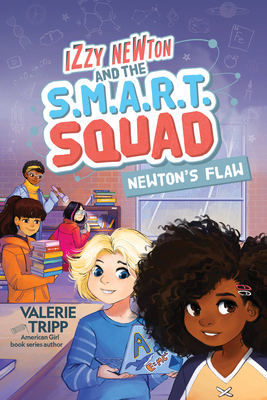 Izzy Newton and the S.M.A.R.T. Squad: Newton’s Flaw (Book 2)
Izzy Newton and the S.M.A.R.T. Squad: Newton’s Flaw (Book 2)
by Valerie TrippUnder the Stars (Nov 02, 2021)
Read Detailed Book Description
When middle-school mishaps happen, five friends form the S.M.A.R.T. Squad and use their collective skills and the power of STEM to bring order to their school. Join Izzy Newton in the second adventure of this fun new fiction series, where science reigns supreme.
With their first mystery solved and first-day jitters triumphantly behind them, Izzy and her pals—the Solving Mysteries and Revealing Truths Squad—start to settle in to the normal day-to-day at Atom Middle School. Izzy even works up the courage to try out for an all-boys sports team! Things are going well until a mysterious illness threatens to shut down the media center—and maybe the entire school. The S.M.A.R.T. Squad is on the case in a race to figure out what ails them. But that’s not all. A pop-up science fair causes excitement and tension for the Squad. And Izzy’s failure to speak up in her speech class feels like an obstacle she can’t overcome. Can the girls pull together to solve the media center mystery? Will their STEM smarts help them rock the science fair? Or will Izzy Newton’s flaws mean the end of the S.M.A.R.T. Squad? Plus, learn more about the real science behind the fiction and meet some amazing real-life scientists.Join award-winning author and American Girl series co-creator Valerie Tripp and the diverse, brilliantly brainy S.M.A.R.T. Squad gang in this charming second book in the series . And don’t forget to check out the first book in the series, Izzy Newton and S.M.A.R.T. Squad: Absolute Hero.
Praise for the series:
It’s one thing to have children’s books about scientists or podcasts or stories about strong women in STEM, but it’s another world entirely when your children get to feel represented by the characters they’re reading about. -Romper
 Cosmic Queries: Startalk’s Guide to Who We Are, How We Got Here, and Where We’re Going
Cosmic Queries: Startalk’s Guide to Who We Are, How We Got Here, and Where We’re Going
by Neil deGrasse TysonNational Geographic Society (Mar 02, 2021)
Read Detailed Book Description
In this thought-provoking follow-up to his acclaimed StarTalk book, uber astrophysicist Neil deGrasse Tyson tackles the world’s most important philosophical questions about the universe with wit, wisdom, and cutting-edge science.
For science geeks, space and physics nerds, and all who want to understand their place in the universe, this enlightening new book from Neil deGrasse Tyson offers a unique take on the mysteries and curiosities of the cosmos, building on rich material from his beloved StarTalk podcast.
In these illuminating pages, illustrated with dazzling photos and revealing graphics, Tyson and co-author James Trefil, a renowned physicist and science popularizer, take on the big questions that humanity has been posing for millennia—How did life begin? What is our place in the universe? Are we alone?—and provide answers based on the most current data, observations, and theories.
Populated with paradigm-shifting discoveries that help explain the building blocks of astrophysics, this relatable and entertaining book will engage and inspire readers of all ages, bring sophisticated concepts within reach, and offer a window into the complexities of the cosmos.
For all who loved National Geographic’s StarTalk with Neil deGrasse Tyson, Cosmos: Possible Worlds, and Space Atlas, this new book will take them on more journeys into the wonders of the universe and beyond
 StarTalk: Everything You Ever Need to Know About Space Travel, Sci-Fi, the Human Race, the Universe, and Beyond
StarTalk: Everything You Ever Need to Know About Space Travel, Sci-Fi, the Human Race, the Universe, and Beyond
by Neil deGrasse TysonNational Geographic (Feb 19, 2019)
Read Detailed Book Description
This illustrated companion to the popular podcast and National Geographic Channel show is an eye-opening journey for anyone curious about our universe, space, astronomy and the complexities of the cosmos.
For decades, beloved astrophysicist Neil deGrasse Tyson has interpreted science with a combination of brainpower and charm that resonates with fans everywhere. This pioneering, provocative book brings together the best of StarTalk, his beloved podcast and television show devoted to solving the most confounding mysteries of Earth, space, and what it means to be human. Filled with brilliant sidebars, vivid photography, and unforgettable quotes from Tyson and his brilliant cohort of science and entertainment luminaries, StarTalk will help answer all of your most pressing questions about our world—from how the brain works to the physics of comic book superheroes. Fun, smart, and laugh-out-loud funny, this book is the perfect guide to everything you ever wanted to know about the universe—and beyond.
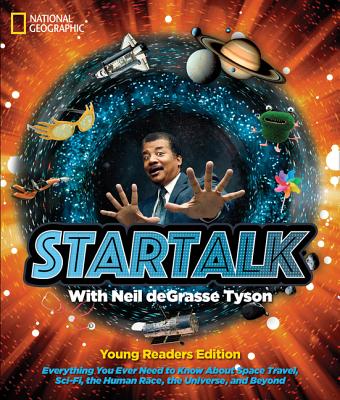 StarTalk Young Readers Edition (Science & Nature)
StarTalk Young Readers Edition (Science & Nature)
by Neil deGrasse TysonNational Geographic Children’s Books (Mar 20, 2018)
Read Detailed Book Description
Now abridged for YA audiences, this beautifully illustrated companion to celebrated scientist Neil deGrasse Tyson’s popular podcast and National Geographic Channel TV show is an eye-opening journey for anyone curious about the complexities of our universe.
For decades, beloved astrophysicist Neil deGrasse Tyson has interpreted science with a combination of brainpower and charm that resonates with fans everywhere. In 2009, he founded StarTalk, the wildly popular podcast that became an Emmy-nominated talk show on the National Geographic Channel in 2015. Tyson’s pioneering book takes the greatest hits from the airwaves to the page in one smart, richly illustrated compendium for young adult readers. Featuring vivid photography, thought-provoking sidebars, enlightening facts, and fun quotes from science and entertainment luminaries like Bill Nye and Josh Groban, StarTalk reimagines science’s most challenging topics—from how the brain works to the physics of comic book superheroes—in a relatable, humorous way that will attract curious young readers.
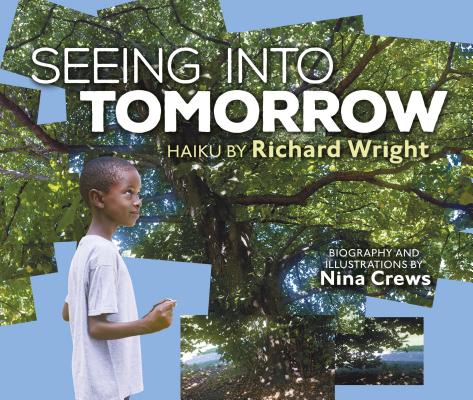 Seeing Into Tomorrow
Seeing Into Tomorrow
by Richard WrightNational Geographic Children’s Books (Feb 01, 2018)
Read Detailed Book Description
Richard Wright’s haiku put everyday momentswalking a dog, watching a sunset, finding a beetleinto focus. Now, more than fifty years after they were written, these poems continue to reflect kids everyday experiences. Paired with the photo collage artwork of Nina Crews, Seeing into Tomorrow celebrates the lives of contemporary African American boys and offers an accessible introduction to one of the most important African American writers of the twentieth century.
 Animal Ark: Celebrating our Wild World in Poetry and Pictures
Animal Ark: Celebrating our Wild World in Poetry and Pictures
by Kwame Alexander and Mary Rand HessNational Geographic Children’s Books (Feb 14, 2017)
Read Detailed Book Description
A howling wolf, a stalking tiger, a playful panda, a dancing bird – pairing the stunning photography of National Geographic photographer Joel Sartore with the delicate poetry of Newbery award-winning author Kwame Alexander, this lush picture book celebrates the beauty, diversity, and fragility of the animal world.
Featuring more than 40 unique animal portraits, the pages invite kids to explore each creature’s markings, textures, and attributes in stunning detail, while calling on all of us to help protect each and every one. Three picture-packed gatefolds inside showcase even more familiar and exotic species. These images are part of Sartore’s lifelong project to photograph every animal in the world, with special attention given to disappearing and endangered species.
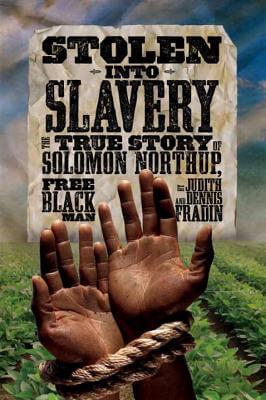 Stolen into Slavery: The True Story of Solomon Northup, Free Black Man
Stolen into Slavery: The True Story of Solomon Northup, Free Black Man
by Judith Bloom Fradin and Dennis Brindell FradinNational Geographic Children’s Books (Jan 10, 2012)
Read Detailed Book Description
The true story behind the acclaimed movie 12 Years a Slave, this book is based on the life of Solomon Northup, a free black man from New York who was captured in the United States and sold into slavery in Louisiana.
Â
Solomon Northup awoke in the middle of the night with his body trembling. Slowly, he realized that he was handcuffed in a dark room and his feet were chained to the floor. He managed to slip his hand into his pocket to look for his free papers that proved he was one of 400,000 free blacks in a nation where 2.5 million other African Americans were slaves. They were gone.
Â
This remarkable story follows Northup through his 12 years of bondage as a man kidnapped into slavery, enduring the hardships of slave life in Louisiana. But the tale also has a remarkable ending. Northup is rescued from his master’s cotton plantation in the deep South by friends in New York. This is a compelling tale that looks into a little known slice of history, sure to rivet young readers and adults alike.
National Geographic supports K-12 educators with ELA Common Core Resources.
Visit www.natgeoed.org/commoncore for more information.
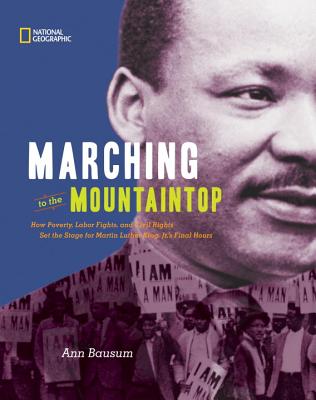 Marching to the Mountaintop: How Poverty, Labor Fights and Civil Rights Set the Stage for Martin Luther King Jr’s Final Hours
Marching to the Mountaintop: How Poverty, Labor Fights and Civil Rights Set the Stage for Martin Luther King Jr’s Final Hours
by Ann BausumNational Geographic Children’s Books (Jan 10, 2012)
Read Detailed Book Description
In early 1968 the grisly on-the-job deaths of two African-American sanitation workers in Memphis, Tennessee, prompted an extended strike by that city’s segregated force of trash collectors. Workers sought union protection, higher wages, improved safety, and the integration of their work force. Their work stoppage became a part of the larger civil rights movement and drew an impressive array of national movement leaders to Memphis, including, on more than one occasion, Dr. Martin Luther King, Jr.
King added his voice to the struggle in what became the final speech of his life. His assassination in Memphis on April 4 not only sparked protests and violence throughout America; it helped force the acceptance of worker demands in Memphis. The sanitation strike ended eight days after King’s death.
The connection between the Memphis sanitation strike and King’s death has not received the emphasis it deserves, especially for younger readers. Marching to the Mountaintop explores how the media, politics, the Civil Rights Movement, and labor protests all converged to set the scene for one of King’s greatest speeches and for his tragic death.
National Geographic supports K-12 educators with ELA Common Core Resources.
Visit www.natgeoed.org/commoncore for more information.
 Denied, Detained, Deported: Stories from the Dark Side of American Immigration
Denied, Detained, Deported: Stories from the Dark Side of American Immigration
by Ann BausumNational Geographic Children’s Books (Apr 14, 2009)
Read Detailed Book Description
With painstaking research, an unerring eye for just the right illustration, and her unique narrative style, award-winning author Ann Bausum makes the history of immigration in America come alive for young people. The story of America has always been shaped by people from all corners of the Earth who came in search of a better life and a brighter future. Immigration remains one of the critical topics in 21st century America, and how our children learn the lessons of the past will shape all our futures.
The patriotic stories of hope that shape most immigration books are supplemented here by the lesser-known stories of those denied, detained, and deported. Ann Bausum’s compelling book presents a revealing series of snapshots from the dark side of immigration history including:
Immigrants Denied: The St. Louis, a ship filled with Jewish refugees from Nazi Germany sought refuge in American ports and was turned away, condemning many of its passengers to ultimately perish in the Holocaust.
Immigrants Detained: Japanese-Americans were rounded up during World War II and placed in detention centers regardless of their patriotism for security reasons.
Immigrants Deported: Emma Goldman was branded a dangerous extremist and sent back to Russia in 1919, after living 30 years in the United States.
Ann Bausum creates a bridge from the lessons of the past to the present with fascinating analysis of how our past has influenced modern events and current views on immigration.
National Geographic supports K-12 educators with ELA Common Core Resources.
Visit www.natgeoed.org/commoncore for more information.
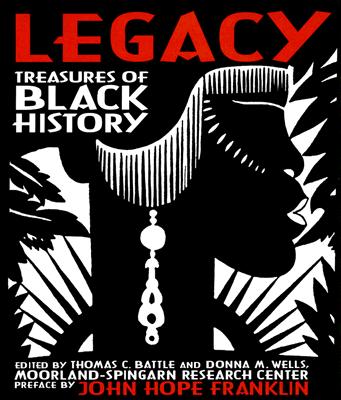 Legacy: Treasures of Black History
Legacy: Treasures of Black History
by Thomas C. Battle and Donna Marcia Wells (editors), and John Hope Franklin (intro)National Geographic (Oct 31, 2006)
Read Detailed Book Description
From its Introduction by the revered and distinguished John Hope Franklin to the bibliography and extensive index that complete it, Legacy represents a major new contribution to African-American history. The Black experience and its impact on our nation’s culture and character come alive in twelve chapters that sweep from ancient Africa and the slave trade to such key eras as the Civil War, Emancipation, and Reconstruction; the Harlem Renaissance and the Jim Crow Era; and the modern Civil Rights and Black Power/Black Arts movements.
The more than 150 historic items showcased here include documents, letters, images, and artifacts, many never before published. Readers will find 18th-century maps of Africa; the pincushion of Elizabeth Keckley, Mrs. Lincoln’s seamstress; Depression-era images by Robert M. McNeil; and a Langston Hughes letter in which he first shares his famous poem I, Too, Sing America. Rare photographs show a unique daguerreotype of Frederick Douglass in profile and the Fisk Jubilee Singers, circa 1880. Objects include a bell of Sally Hemmings, Thomas Jefferson’s slave and companion, and NAACP membership buttons from the 1960s. More than two dozen prominent Black scholars and activists offer expert insights on the collection, on subjects ranging from traditional African societies to 21st-century art and politics, making this book as definitive as it is beautiful—a priceless resource that will inform and fascinate serious students and casual readers alike.
 In Motion: The African-American Migration Experience
In Motion: The African-American Migration Experience
by Schomburg Center for Research in Black Culture, Howard Dodson, and Sylviane A. Diouf
National Geographic (Jan 01, 2005)
Read Detailed Book Description
African Americans, more than any other populations in the Americas, have been shaped by migrations. Their culture and history are the products of black peoples’ various movements, coerced and voluntary, that started, in the Western Hemisphere, five hundred years ago. Theirs is the story of men and women forced out of Africa; of enslaved people moved from the coastal southeast to the Deep South; of fugitives walking to freedom across the country and beyond; of colonists leaving their land to settle on foreign shores; of southerners migrating west and north; and of immigrants arriving from the Caribbean, South America, and Africa.
Although the Atlantic slave trade has created an enduring image of black people as transported commodities, and is usually considered the single element in the construction of the African Diaspora, it is centuries of additional migrations that have given shape to the nation we know today, a nation different from that forged solely by the dreadful transportation of the Africans against their will. And it is this vast array of migrations that truly defines the African American experience. Always on the move, resourceful, and creative, men and women of African origin have been risk-takers in an exploitative and hostile environment. Their survival skills, efficient networks, and dynamic culture have enabled them to thrive and spread, and to be at the very core of the settling and development of the Americas. Their migrations have changed not only their world, and the fabric of the African Diaspora but also their nation and the Western Hemisphere.
Between 1492 and 1776, an estimated 6.5 million people migrated to the Americas. More than 5 out of 6 were Africans. The major colonial labor force, they laid the economic and cultural foundations of the continents. Their migrations continued during and after slavery. In the United States alone, 6.5 million African Americans left the South for northern and western cities between 1916 and 1970. With this internal Great Migration, the most massive in the history of the country, African Americans stopped being a southern, rural community to become a national, urban population.
The men and women of the Great Migration not only transformed the cities they settled in, but their neighborhoods became primary destinations for black people arriving from the Caribbean, Africa, and South America. These immigrants often retained their national and ethnic identities, and brought new resources into the African American community. With each wave of migration, changes in the demographic, cultural, religious, economic, and political life of the recipient communities occurred; and the nation’s development has been inextricably linked with these movements.
At the same time, from the earliest days, thousands of African Americans have left their country when it became apparent that they would not find at home the freedom and equality they aspired to. Their quest for liberty and better opportunities took them to Canada, Mexico, the Caribbean, and Africa. African American out-migration has now become insignificant, but black popular culture, created out of the diverse influences brought about by centuries of movement, resonates throughout the world in an unprecedented cultural migration.
Today’s 35 million African Americans are heirs to all the migrations that have formed, modeled, and transformed their community, the country, and the African Diaspora. They are the offspring of diverse African ethnicities who also include, in their genetic makeup, Europeans, Native Americans, and Asians. They represent the most diverse population in the nation. A population that has embraced its varied heritage built by millions of men and women constantly on the move, looking for better opportunities, starting over, paving the way, and making sacrifices for future generations.
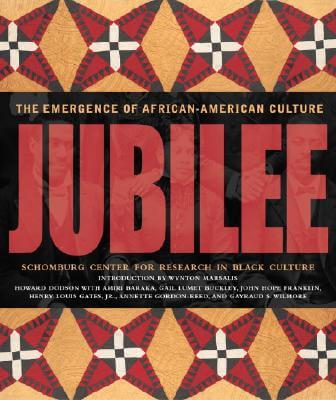 Jubilee: The Emergence of African-American Culture
Jubilee: The Emergence of African-American Culture
by Howard Dodson, Amiri Baraka, Gail Lumet Buckley, Henry Louis Gates, Jr., and Annette Gordon-ReedNational Geographic (Feb 01, 2003)
Read Detailed Book Description
The word jubilee means, among other things, a celebration in anticipation of future happiness. Based on new scholarship by the Schomburg Center, Jubilee presents a fresh, new perspective on how enslaved Africans triumphed over slavery. Working as creative agents of their own destiny within the shackles of slavery, enslaved Africans reinvented themselves as a new people - a new American people - laying the foundations for truly unique African-American social, cultural, political, and economic expressions throughout the Western Hemisphere. With almost two hundred illustrations, including early slave ship manifests, manumission papers, early photographs of slaves and of freed African-Americans, paintings, and artifacts from shackles to freedom quilts.
